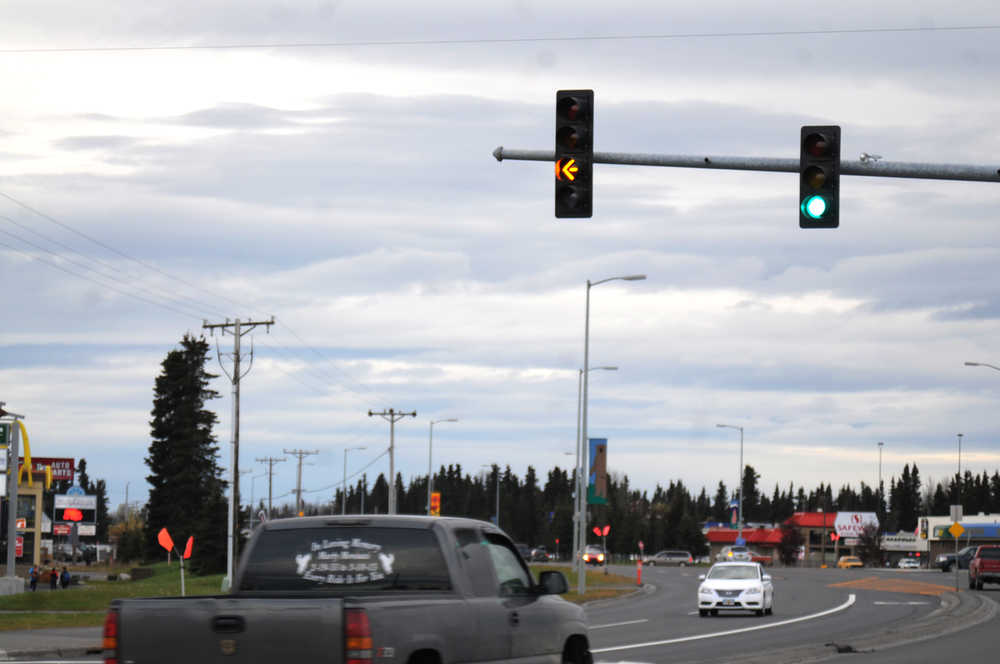Drivers in Kenai and Soldotna have had to follow a new directive since the completion of construction earlier this fall — a flashing yellow arrow.
The new traffic signals were installed on roadways in Kenai and Soldotna as part of an Alaska Department of Transportation and Public Facilities project to make turning left at intersections safer. The directive itself is fairly basic — when the yellow arrow is flashing, drivers should yield to oncoming traffic, pedestrians and vehicles in the intersection before making a left turn.
Turns in intersections, particularly left hand turns, are a problem, contributing significantly to accidents, according to reports from the National Highway Traffic Safety Administration in 2008 and 2010. As traffic on urban roads has increased, the space between cars to make a left turn has contracted, making it more dangerous to turn left. Intersections with left turn signals make it easier, but traffic slows down to allow them to do so.
Instead of simply giving driver the right of way or forcing them to stop, the flashing yellow arrow allows them to make decisions based on what they see, said Jeremy Woodrow with the DOT Commissioner’s office.
“They can be safer, but it also helps reduce congestion,” Woodrow said. “It allows drivers to make smart decisions.”
The state installed the first one in 2009 in Juneau as a test, expanding them in Juneau in 2012. Flashing yellow arrow signals can now be found in Anchorage, Wasilla, Fairbanks, Juneau, Sitka, Ketchikan, Kenai and Soldotna, Woodrow said in an email.
Though DOT has not kept specific crash data at the intersections to measure success in reducing crashes, national data has shown a 35 percent reduction for left-turn crashes in intersections with the flashing yellow arrow.
“This is a significant decrease, which strongly supports the department’s decision to improve intersections where appropriate across the state with the addition of Flashing Yellow Arrows,” Woodrow said in the email.
In the construction this summer, 13 flashing yellow arrow signals were installed in Kenai and Soldotna, bring the statewide number up to 68, said Shannon McCarthy, public information office for DOT’s central region.
The signal replacement, which cost $4.7 million, was almost entirely funded by the Federal Highway Administration through a program for reducing injury crashes, McCarthy said.
The decisions on where to place the new signals were based on traffic crash data from one intersection — where the Kenai Spur Highway meets Airport Road in Kenai — and applied to other intersections with similar characteristics, McCarthy said in an email.
“In terms of the other intersections, we won’t have a lot of crash data,” she said. “What we did is we’ll show that the same conditions exist in those intersections.”
In the intersection of Binkley Street and the Sterling Highway, a busy intersection near Safeway in Soldotna, there were 12 property damage crashes and three minor injury crashes that could have been prevented by the flashing yellow arrow, McCarthy said an email. The numbers are more compelling in the Anchorage and Mat-Su areas, which have much higher volumes of traffic every day, but the Binkley Street intersection is a good example, she said.
The state does not have data for all the intersections with flashing yellow arrows because there is not enough complete data to draw from yet — the state’s data is always about three years behind, and because the flashing yellow arrows have only been around for about four years, there isn’t enough information yet, she said. There will be specific information eventually, she said.
Reach Elizabeth Earl at elizabeth.earl@peninsulaclarion.com.

